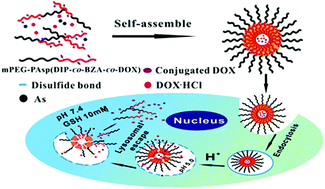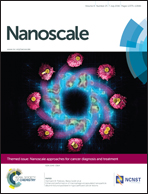Co-delivery of doxorubicin and arsenite with reduction and pH dual-sensitive vesicle for synergistic cancer therapy†
Abstract
Drug resistance is the underlying cause for therapeutic failure in clinical cancer chemotherapy. A prodrug copolymer mPEG-PAsp(DIP-co-BZA-co-DOX) (PDBD) was synthesized and assembled into a nanoscale vesicle comprising a PEG corona, a reduction and pH dual-sensitive hydrophobic membrane and an aqueous lumen encapsulating doxorubicin hydrochloride (DOX·HCl) and arsenite (As). The dual stimulation-sensitive design of the vesicle gave rise to rapid release of the physically entrapped DOX·HCl and arsenite inside acidic lysosomes, and chemically conjugated DOX inside the cytosol with high glutathione (GSH) concentration. In the optimized concentration range, arsenite previously recognized as a promising anticancer agent from traditional Chinese medicine can down-regulate the expressions of anti-apoptotic and multidrug resistance proteins to sensitize cancer cells to chemotherapy. Consequently, the DOX-As-co-loaded vesicle demonstrated potent anticancer activity. Compared to the only DOX-loaded vesicle, the DOX-As-co-loaded one induced more than twice the apoptotic ratio of MCF-7/ADR breast cancer cells at a low As concentration (0.5 μM), due to the synergistic effects of DOX and As. The drug loading strategy integrating chemical conjugation and physical encapsulation in stimulation-sensitive carriers enabled efficient drug loading in the formulation.

- This article is part of the themed collection: Nanoscale approaches for cancer diagnosis and treatment

 Please wait while we load your content...
Please wait while we load your content...